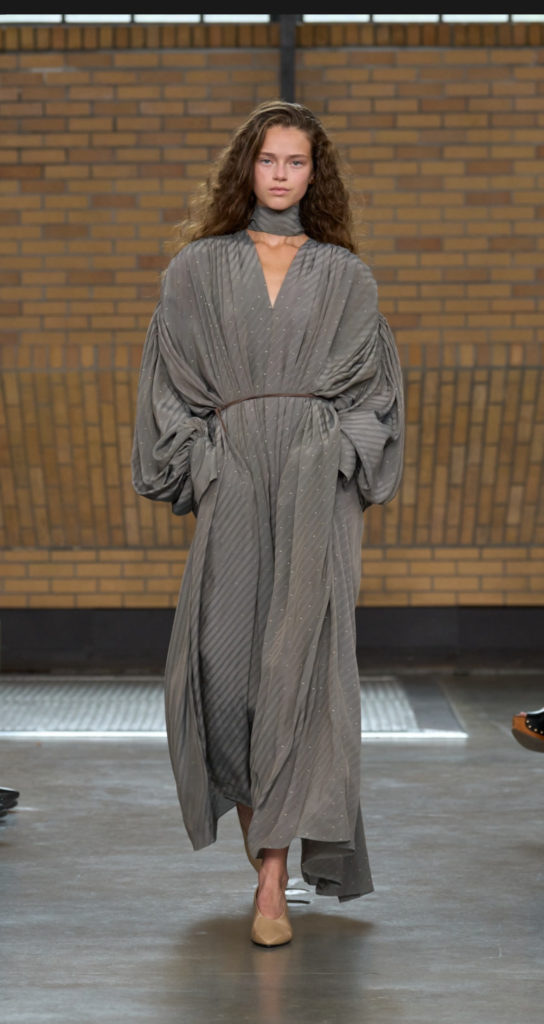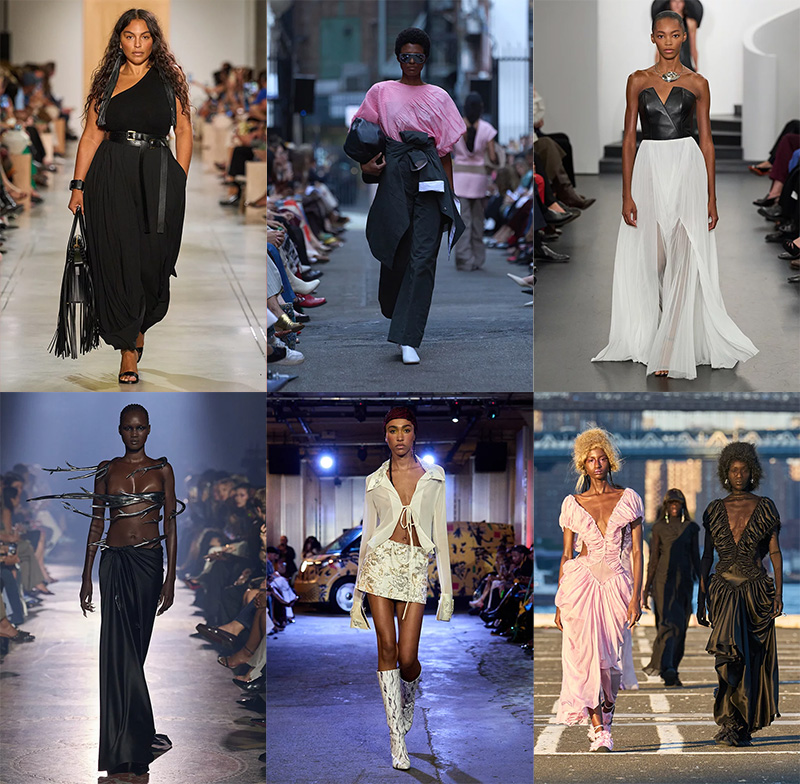
What are American designers dreaming of for Spring-Summer 2026? In a world clouded by uncertainty, fashion has chosen to breathe in lightness. Clients crave a sense of ease embodied in the billowing harem pants at Michael Kors, the sensual knit dresses at Proenza Schouler, and the whisper of soft pink blouses at Rachel Comey. Between bold statements and subtle trends, here’s the ultimate best of from New York Fashion Week.
Author Archives: admin
DEMNA’S NEW VISION FOR GUCCI
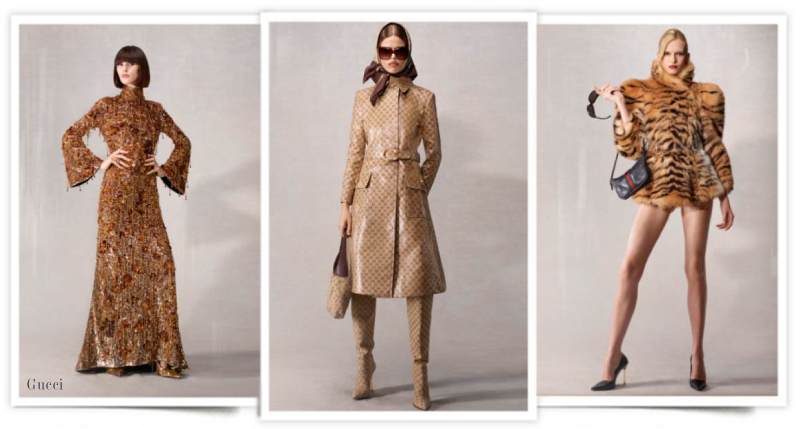 To convey the full “Gucci spirit,” Demna imagined a series of characters gathered under the name “La Famiglia,” each with their own personality and distinctive attitude. In collaboration with Francesca Bellettini, the newly appointed president and CEO, the designer chose to unveil a look book photographed by Catherine Opie on Monday, ahead of the short film The Tiger, directed by Spike Jonze and Halina Reijn, which will be presented Tuesday evening in Milan. Continue reading
To convey the full “Gucci spirit,” Demna imagined a series of characters gathered under the name “La Famiglia,” each with their own personality and distinctive attitude. In collaboration with Francesca Bellettini, the newly appointed president and CEO, the designer chose to unveil a look book photographed by Catherine Opie on Monday, ahead of the short film The Tiger, directed by Spike Jonze and Halina Reijn, which will be presented Tuesday evening in Milan. Continue reading
THE FAKE MARTYR OF MAGA CIVILIZATION
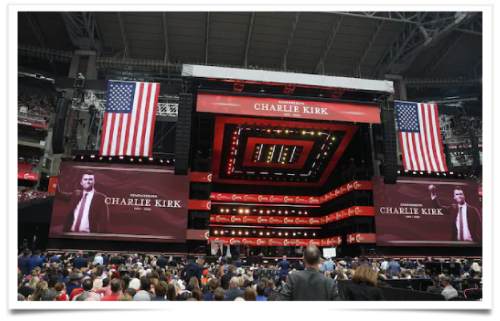 What a vile farce, what a grandiose comedy this televised mass for that Maga YouTuber, this liturgy of a stuffed corpse in global broadcast! They shower him with incense, they weep like hysterical church ladies before the coffin of a cardboard prophet, a racist antisemite disguised as a universal martyr! We are force-fed with violins and rancid speeches, as if the sanctified carrion could wash away our collective sins!
What a vile farce, what a grandiose comedy this televised mass for that Maga YouTuber, this liturgy of a stuffed corpse in global broadcast! They shower him with incense, they weep like hysterical church ladies before the coffin of a cardboard prophet, a racist antisemite disguised as a universal martyr! We are force-fed with violins and rancid speeches, as if the sanctified carrion could wash away our collective sins!
And so, the uncultured American masses, flabby-bellied, stuffed with slogans and images, hypnotized by the media liturgy, applaud, cross themselves, click like, share, and the next day return to their supermarket errands, their debts, their petty miseries! That’s the real miracle: turning the vile into the sublime, infamy into heroism!
Malraux once said: the 21st century will be religious… but who could have imagined it would come in this grotesque form, this morbid fair, this circus of sanctified corpses and politicians in vestments? The border between politics and religion? It’s already shattered! The rulers kneel, the priests bless, the cameras broadcast: everything dissolves into the same stinking stew of hypocrisy! Continue reading
DILARA FINFIKOLU 2026
 Enough! Let us put an end to this travesty of style’s History, dressed up only to amuse the fashionable gallery. Gothic was not born in some backroom of Central Saint Martins between two Instagram selfies and a sponsored “rebellious” performance. No: it was conceived, forged, and imposed on fashion by Jean-Luc Amsler. Full stop.
Enough! Let us put an end to this travesty of style’s History, dressed up only to amuse the fashionable gallery. Gothic was not born in some backroom of Central Saint Martins between two Instagram selfies and a sponsored “rebellious” performance. No: it was conceived, forged, and imposed on fashion by Jean-Luc Amsler. Full stop.
And now we’re supposed to swallow the idea that Dilara Findikoglu with a name fit for a roadside inn is the high priestess of darkness? What a farce! Here is a designer who proclaims herself subversive, yet only extends her hand to the market like a carnival barker. Her so-called “punk” is nothing but a runway special effect, her “feminism” a Turkish sales tag, and her “gothic” a kind of watered-down carnival for gullible spectators.
Her grand show “Cage of Innocence”? A cage indeed: one where imagination is locked up and reduced to a Versailles-style amusement park backdrop. Marie-Antoinette had her Hamlet of the Queen, Findikoglu will have her Disneyland of lace-clad anguish. Add a little pink, a little white, just enough to reassure investors and clients and voilà, “radicality” becomes Instagrammable! Continue reading
KIDSUPER SPRING 2026
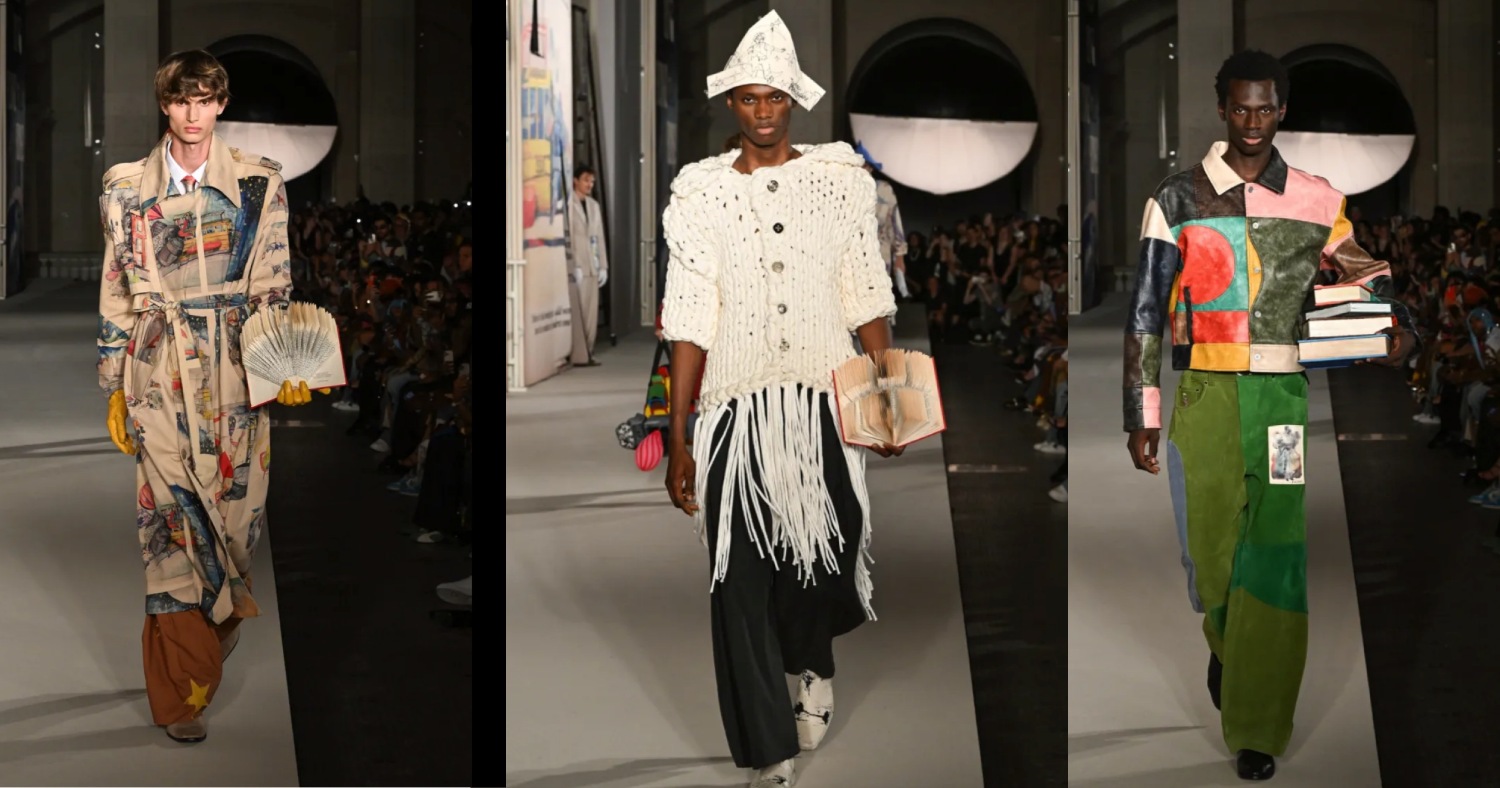
It takes nerve to christen a brand. Some choose discretion, elegance, a subtle reference. KidSuper, on the other hand, went for the gaudy glare of a “SUPER” promise. But what is truly super here, other than an inflation of ego and a caricature of half-digested creativity?
This is a shrill advertisement for a world that confuses genius with tomfoolery. From the name alone, everything is clear: a fashion that struts around under the pretense of boldness. “Kid” stands for regression, “Super” for excess. One can almost hear a child dressing up as a superhero with scraps of garish fabric. Continue reading
KERING INVENTS CEO SPEED-DATING
 Kering seems to have found the miracle cure for all its problems: changing (yet again) the CEO at Gucci. After nine months in the role, Stefano Cantino—barely the length of a maternity leave or two fashion seasons—has already been shown the door. Apparently, in luxury, instability is the new must-have accessory.
Kering seems to have found the miracle cure for all its problems: changing (yet again) the CEO at Gucci. After nine months in the role, Stefano Cantino—barely the length of a maternity leave or two fashion seasons—has already been shown the door. Apparently, in luxury, instability is the new must-have accessory.
The new star in sight? Francesca Bellettini is being touted as “one of the most accomplished executives,” a former Goldman Sachs alum—in other words, the perfect candidate to wear impeccable suits while juggling Excel spreadsheets. Her arrival is being sold as a “crucial moment” by Luca de Meo, Kering’s new boss, who hasn’t even had time to set down his office plant before launching into a full-scale clean-up. Continue reading
RH – THE ECLIPSE OF REFINEMENT
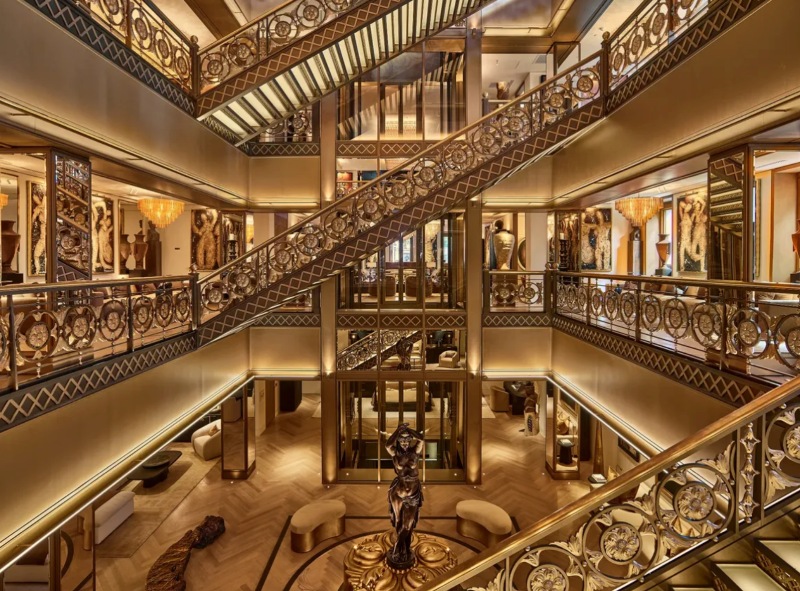 So here we are, presented with yet another temple of luxury, erected like a manifesto of ostentatious grandeur, with its seven levels piled up like the vanities of a world already overfed. A design gallery, two culinary spaces, an interior studio… it reads like a catalog of desires packaged in marble and glass. Paris, once again summoned as a postcard backdrop, finds itself ordered to host this transatlantic hybrid: half American dream bunker, half French palace of illusions.
So here we are, presented with yet another temple of luxury, erected like a manifesto of ostentatious grandeur, with its seven levels piled up like the vanities of a world already overfed. A design gallery, two culinary spaces, an interior studio… it reads like a catalog of desires packaged in marble and glass. Paris, once again summoned as a postcard backdrop, finds itself ordered to host this transatlantic hybrid: half American dream bunker, half French palace of illusions.
And already, the specialized media wave their censers: “success,” “innovation,” “international clientele”… As if the philosopher’s stone of high-end retail had just been discovered. But what revelation is there, other than the repetition of the same equation? Money, staging, a hint of lifestyle, and the illusion of endless refinement. One almost regrets that the Lord Himself did not do this with La Samaritaine. Continue reading
HOW THE ZIPPER WAS INVENTED
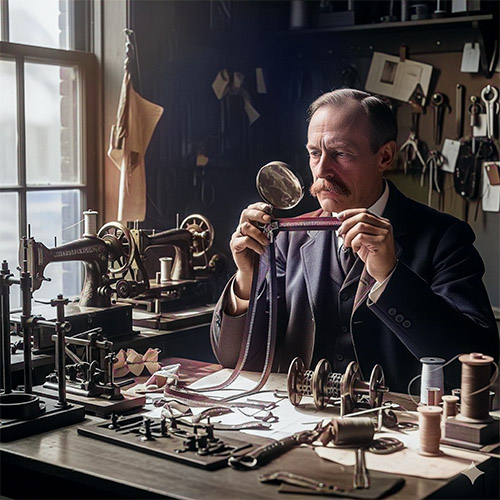 The zipper, commonly called a zip, is today an everyday object, found on jeans, bags, coats, or even shoes. It is so widespread that we almost forget it was the result of a patient invention, the fruit of several attempts before becoming established.
The zipper, commonly called a zip, is today an everyday object, found on jeans, bags, coats, or even shoes. It is so widespread that we almost forget it was the result of a patient invention, the fruit of several attempts before becoming established.
The first experiments date back to the 19th century. In 1851, the concept emerged for the first time when Elias Howe, the inventor of the sewing machine, filed a patent for an “automatic clothing closure device.” But his idea went nowhere: the time was not yet ripe, and his system was considered too complex.
A few decades later, in 1891, an American engineer, Whitcomb Judson, imagined a “sliding fastener” system, mainly intended for shoes. He presented it at the Chicago World’s Fair in 1893. But this prototype, unreliable and difficult to use, failed to achieve commercial success.
The real turning point came in 1913, thanks to Gideon Sundback, a Swedish engineer who had emigrated to the United States. By improving Judson’s model, he developed a more practical mechanism: two strips of fabric fitted with metal teeth that interlock using a slider. Sundback filed his patent in 1917, and his invention quickly became the first functional zipper. Continue reading
NEW YORK 2026 USELESS BUT ESSENTIAL

CAVIN KLEIN 2026
TRAPANI DIES AT 68
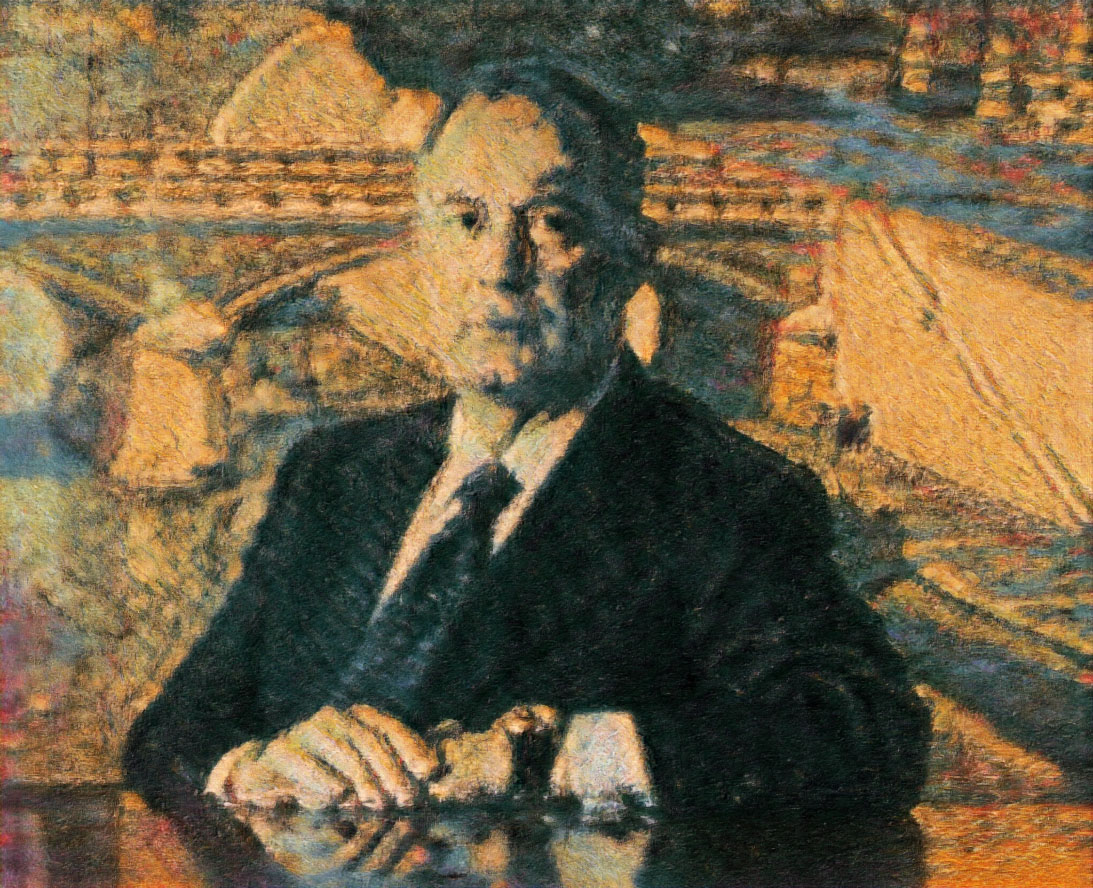 Luxury industry entrepreneur and investor Francesco Trapani has passed away in Rome at the age of 68. The son of Lia Bulgari and nephew of Gianni, Paolo and Nicola Bulgari, he had, according to the statement, “inherited a profound passion for excellence, creativity and innovation.”
Luxury industry entrepreneur and investor Francesco Trapani has passed away in Rome at the age of 68. The son of Lia Bulgari and nephew of Gianni, Paolo and Nicola Bulgari, he had, according to the statement, “inherited a profound passion for excellence, creativity and innovation.”
Appointed chief executive officer of the Roman house in 1984, he led Bulgari for three decades, transforming the company into one of the world’s most iconic jewelry brands and an international leader in luxury. Visionary and bold, Francesco Trapani redefined the boundaries of the industry, strengthening Bulgari’s global presence and establishing it as a symbol of Italian elegance and contemporary refinement. His strategic insight and relentless drive not only shaped the future of the maison but also left a lasting mark on the entire luxury sector.
The funeral will take place on Saturday at noon at the Basilica di Santa Croce in Gerusalemme in Rome.
THE RIDDLE OF THE HEADBAND
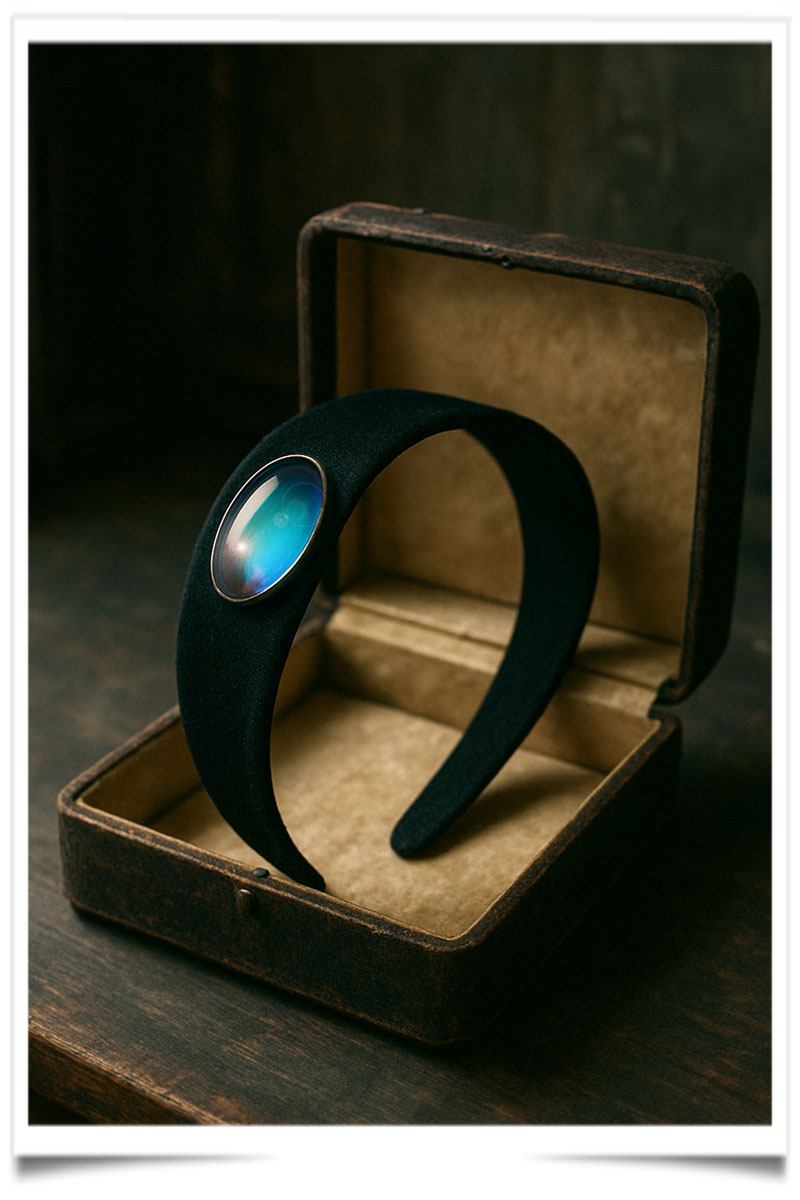
It is said that at the bottom of an old chest at the Grès house, abandoned for decades, lay a mysterious accessory. It was a deep black headband, adorned with a single translucent stone that seemed to change color depending on the light. No one claimed its origin, not even Madame Alix, and nothing in the house archives. The oldest hands said they had always seen it, lying there, as if no one had dared to move it.
Yet, every time an apprentice or a model, out of curiosity, placed it on their head, something strange happened: the way others looked at it changed. Some saw the person as more elegant, others more disturbing, almost fascinating. As if the headband projected a different aura for each person.
THE US OPEN TURNED INTO A DUMP FOR BOTOXED BIMBOS
 The US Open! This tournament, supposed to be the pinnacle of sport, the embodiment of merit, sweat, self-sacrifice, those hours of solitude on the court and training, that merciless discipline that makes an athlete a champion. And what are we being sold in endless glossy columns and sponsored Instagram posts? Certainly not the sporting achievement, but the pathetic parade of a “court of mirages”: Botoxed stars, supermarket bimbos, silicone clones, and interchangeable influencers whose only contribution to humanity is a plastic smile and a promo code for a pair of sneakers mass-produced by children.
The US Open! This tournament, supposed to be the pinnacle of sport, the embodiment of merit, sweat, self-sacrifice, those hours of solitude on the court and training, that merciless discipline that makes an athlete a champion. And what are we being sold in endless glossy columns and sponsored Instagram posts? Certainly not the sporting achievement, but the pathetic parade of a “court of mirages”: Botoxed stars, supermarket bimbos, silicone clones, and interchangeable influencers whose only contribution to humanity is a plastic smile and a promo code for a pair of sneakers mass-produced by children.
The contrast is obscene. On one side, players who transform their bodies into precision instruments, who pay for each victory with blood and tears. On the other, a gallery of idle, thoughtless, worthless extras who make their navels an idol of cosmetic surgery, their only asceticism.
Sport is diverted from its essence to become the backdrop for a walking advertisement for emptiness, a podium offered to these new aristocrats of nothingness. They produce nothing, create nothing, inspire nothing, except an abysmal fatigue in the face of the degradation of the sporting spectacle.
HAUTCOEUR THE NEW FACE OF VERSACE COMMUNICATIONS

She steps into the role after Mathieu Baboulène, and will now report to Caroline Deroche Pasquier, who joined Versace last year as vice president of global communications following a celebrated tenure at Bottega Veneta.
True to her Kering roots, Hautcoeur moved to London in 2021 to take on the role of head of communications for Northern Europe at Bottega Veneta. A strategic position at the heart of a house on the rise, it allowed her to sharpen her expertise across key markets. Continue reading
SKIN REBORN UNDER THE SUN
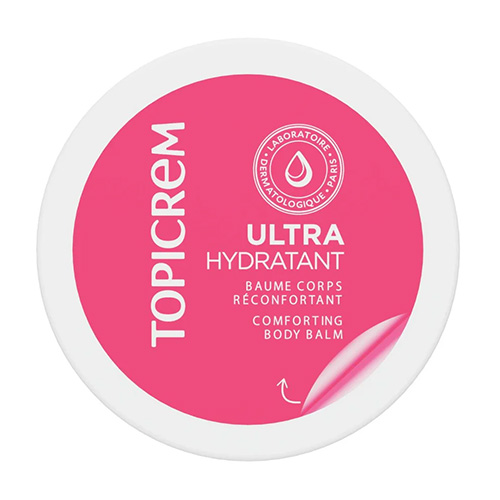 Never, since the blissful hours when my childlike soul wandered along the shores of Saint-Malo with my kittens, had my body known such affliction. Brittany, mother of winds and waves, had given me back, along with the copper glow of summer days, the dryness and tugging of its salty nights. My skin, once supple as a morning leaf, bore the marks of a blazing sun, stinging sand, and a bitter breeze. My heart, faithful to the sea’s promise, nonetheless found itself captive within this tormented body.
Never, since the blissful hours when my childlike soul wandered along the shores of Saint-Malo with my kittens, had my body known such affliction. Brittany, mother of winds and waves, had given me back, along with the copper glow of summer days, the dryness and tugging of its salty nights. My skin, once supple as a morning leaf, bore the marks of a blazing sun, stinging sand, and a bitter breeze. My heart, faithful to the sea’s promise, nonetheless found itself captive within this tormented body.
It was then, amidst my dismay, that Topicrem Ultra-Moisturizing Body Balm appeared, like a remedy to earthly woes. Its formula, rich in shea butter and beeswax, became a soothing anointment for my wounded skin. From the very first application, it dispelled the arid veil covering my flesh, and the promise of forty-eight hours of softness became a tangible reality. The skin, once rough and flaking, regained the suppleness and velvet touch of a ripe peach. Continue reading
PRINTEMPS CEO BELLAICHE STEPS DOWN
 Printemps Fires Its Boss With the Usual Formula: “Thank You for Your Commitment”
Printemps Fires Its Boss With the Usual Formula: “Thank You for Your Commitment”
Sometimes there are phrases so moth-eaten from overuse that they reek of formaldehyde, serving only to mask embarrassing realities. Printemps’ press release announcing the departure of Jean-Marc Bellaiche after five years at the helm is a textbook example: “We would like to thank Jean-Marc Bellaiche for his commitment and the successful transformation he has led.” HR translation: “Thanks for dropping by, the door’s over there.”
But Bellaiche didn’t walk into a serene household. He took over right in the middle of the pandemic, when department stores were emptying out and Chinese tourists once the golden goose were stuck at home. He patched up the leaks, launched e-commerce just as everyone else was pulling down the shutters, and even splurged on a New York opening at the imposing One Wall Street, as if to remind the world that Printemps still liked to dream big. Continue reading
THE SILENCE OF A PRINCE FOR THE ETERNITY OF A STYLE
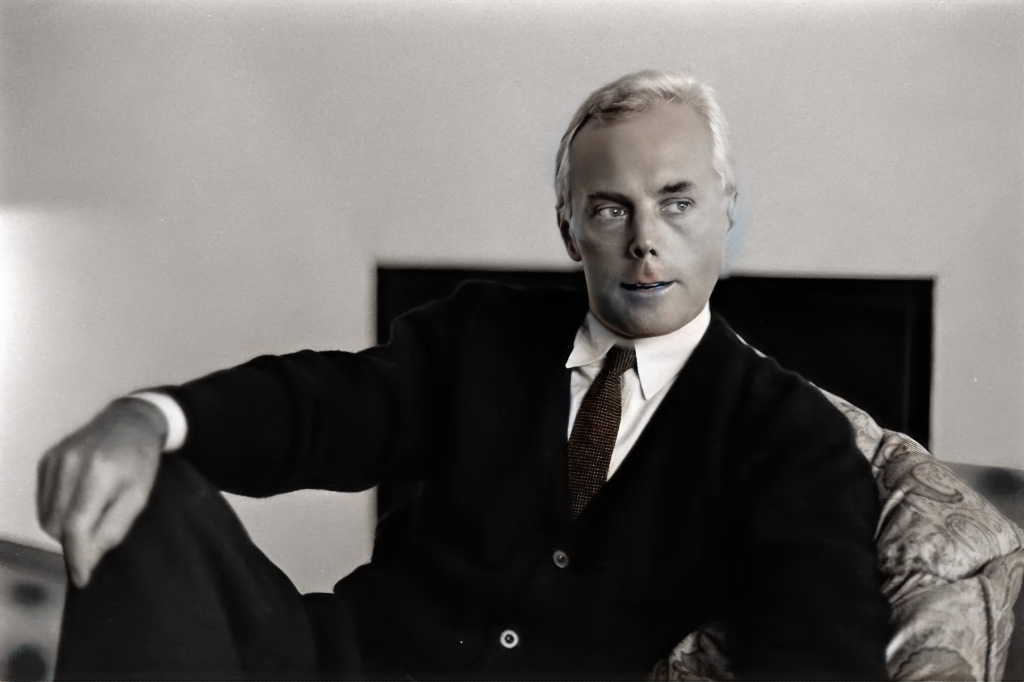 A peaceful farewell rises for this breath of elegance: on the morning of September 4, 2025, a light went out. Giorgio Armani, in his ninety-first year, has departed, surrounded by his loved ones, leaving upon the fabric of time the indelible imprint of a style that has become memory.
A peaceful farewell rises for this breath of elegance: on the morning of September 4, 2025, a light went out. Giorgio Armani, in his ninety-first year, has departed, surrounded by his loved ones, leaving upon the fabric of time the indelible imprint of a style that has become memory.
Like a star whose path spans the centuries, he glided through the eras, reinventing masculine and feminine forms, imposing upon fashion a new physiognomy—simple and sublime at once. His vision, fluid and solemn like an ancient river, unrolled over the world an invisible carpet: from Milan to Hollywood, reaching even into the very souls of those who wore his creations as one might don a poem. Continue reading
LVMH THE PRICE CAVIAR CRUMBS FOR HUNGRY BIRDS
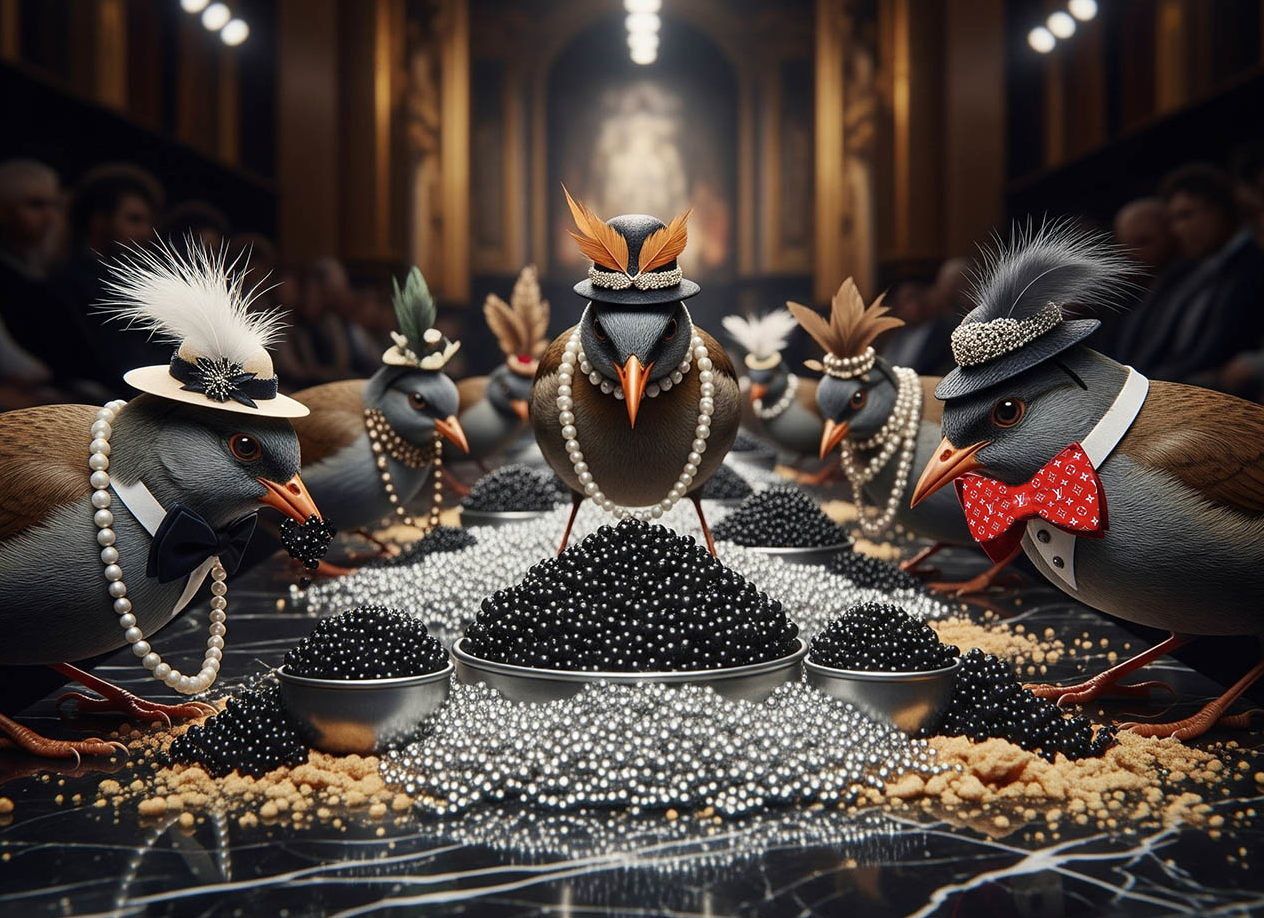
The LVMH Prize for Young Designers, supposedly the embodiment of fashion’s future, has it not become just another showcase for the gigantism of an empire obsessed with admiring itself in its own mirrors?
Yes, it celebrates “emerging talent,” but through carefully staged ceremonies, parachuted celebrity ambassadors, and a self-congratulatory luxury industry handing out neatly packaged checks like tossing a few crumbs of caviar to hungry birds.
Soshi Otsuki, awarded by the Fondation Louis Vuitton, becomes the new flag-bearer of this liturgy of “controlled innovation.”
We hear of coaching by LVMH experts but what kind of coaching? The kind that molds designers into Arnault tiny houses, primed to manufacture profitable dreams? Continue reading
JEAN BARTHET THE ART OF SHAPING DREAMS IN HATS
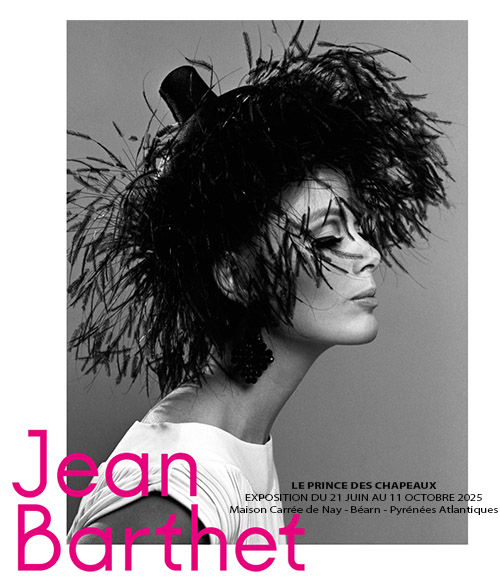 He was from Béarn, yet his name will forever resonate along the avenues of Paris and on the world’s red carpets. Jean Barthet, a genius milliner, shaped hats the way others write poems: letting audacity and grace dance together on a single thread.
He was from Béarn, yet his name will forever resonate along the avenues of Paris and on the world’s red carpets. Jean Barthet, a genius milliner, shaped hats the way others write poems: letting audacity and grace dance together on a single thread.
I remember those dinners in his apartment in the 16ᵗʰ arrondissement, after a day spent at the factory of his perfumes. The table would glow with laughter, raised glasses, and anecdotes in which the stars of cinema and couture seemed almost familiar. Barthet had that rare gift: turning the ordinary into a celebration, and everyday life into legend.
Grace Kelly, Brigitte Bardot, Sophia Loren, Lauren Bacall, Catherine Deneuve, Michael Jackson… all, at one time, were crowned by his imagination. His hats were not mere accessories: they were fragments of light, shards of dream, signatures of style.
Today, in Nay, at the Maison Carrée, his brilliance is being celebrated for the first time. The exhibition, designed by his son Alexandre, unfolds more than forty years of creation: hats, photographs, sketches, films, memories. A universe where glamour meets craftsmanship, where one understands that elegance is an architecture of the soul. Continue reading
FASHION RESET WHY
 For a long time a symbol of eternity and prosperity, luxury today is facing a deep crisis. While prestigious houses still retain their aura, their model is weakened by economic, social, and cultural upheavals. Several factors explain this decline.
For a long time a symbol of eternity and prosperity, luxury today is facing a deep crisis. While prestigious houses still retain their aura, their model is weakened by economic, social, and cultural upheavals. Several factors explain this decline.
1. An excessive dependence on emerging clientele
For the past two decades, the growth of luxury has relied almost exclusively on the wealthy classes of China, Southeast Asia, and the Middle East. However, China’s economic slowdown, stricter taxes on imported products, and travel restrictions due to geopolitical tensions have curbed this demand. Houses, overexposed to these markets, are seeing their sales plummet.
2. The erosion of desire in the face of banalization
Luxury is no longer rare. Massive communication campaigns, the omnipresence of logos, and the opening of stores in every capital have turned the exceptional into a commonplace product. What was once reserved for a cultured elite is now within reach thanks to credit or online resale. As a result, symbolic value erodes, and luxury items no longer impress. Continue reading
EXCLUSIVITY VS FAST-LUXURY
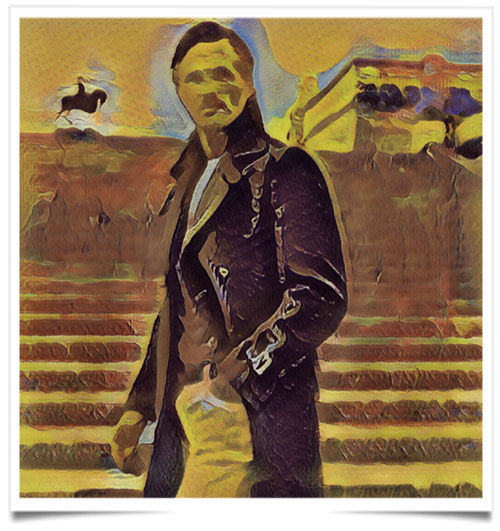 During an interview in Milan to comment on his company’s solid results, Brunello Cucinelli reminded everyone that he was speaking on behalf of a house “firmly positioned at the exclusive level.”
During an interview in Milan to comment on his company’s solid results, Brunello Cucinelli reminded everyone that he was speaking on behalf of a house “firmly positioned at the exclusive level.”
“Too often, desirability has replaced exclusivity. An iPhone may be desirable, but it is not exclusive,” he explained.
French groups, however, see things differently: “Why bother with exclusivity when you can sell tote bags with giant logos to everyone?”
While Cucinelli has repeated for years that there are no shortcuts to true quality, some French champions have invented the concept of fast-luxury: XXL margins, XXL outsourcing… and sometimes S-sized quality.
“Young people are wary of companies reporting excessive profits,” added Cucinelli. On the French side, the motto is closer to: “If they don’t see our astronomical profits, how will they know we’re luxurious?” Continue reading
ZHANG RUONAN GIVENCHY’S NEW FACE
 It’s official: Givenchy has found its ambassador in China, and her name is Zhang Ruonan. The Chinese star had already hinted at her fashion love affair during Sarah Burton’s very first Givenchy show last March. For the occasion, she wore an asymmetrical papaya-colored dress’ that fruit we’re never quite sure about at breakfast but absolutely adore turning into a fashion statement. In her hand: a mini Antigona bag in box leather, barely big enough to hold a credit card, two Tic Tacs, and a reasonably sized ego.
It’s official: Givenchy has found its ambassador in China, and her name is Zhang Ruonan. The Chinese star had already hinted at her fashion love affair during Sarah Burton’s very first Givenchy show last March. For the occasion, she wore an asymmetrical papaya-colored dress’ that fruit we’re never quite sure about at breakfast but absolutely adore turning into a fashion statement. In her hand: a mini Antigona bag in box leather, barely big enough to hold a credit card, two Tic Tacs, and a reasonably sized ego.
“Givenchy is a brand I adore very much,” Ruonan declared, proving once again that in 2025 redundancy remains the purest form of love. We’re eagerly awaiting her next compliments: “I adore it enormously,” “I passionately love it a lot,” or even “I freaking love it hardcore.”
At Givenchy, they’re rubbing their hands with glee. A young, glamorous ambassador capable of making papaya suddenly desirable is a surefire guarantee to boost sales faster than a handbag featured in an Instagram story. As for the fans, they’d better prepare for the new Givenchy-Ruonan era: fruity, asymmetrical, and just a little cartoonish.
FM
THE MAN WHO MADE SPROTSWEAR DESIRABLE
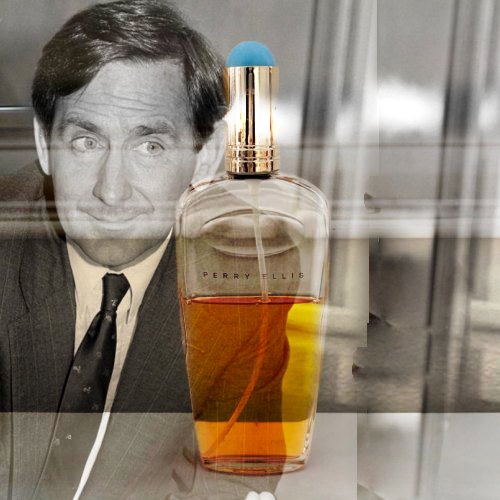 In the grand narrative of American style, Perry Ellis wrote a chapter that belonged only to him. Far from the clichés of utilitarian sportswear, he infused it with a charm that was at once classic and free, a playful modernity, never without a touch of gentle irony.
In the grand narrative of American style, Perry Ellis wrote a chapter that belonged only to him. Far from the clichés of utilitarian sportswear, he infused it with a charm that was at once classic and free, a playful modernity, never without a touch of gentle irony.
“There are few clothes that have never been made. It’s the little extras that make them unique,” he confided in 1976. Those “little extras” were precisely his signature: a shirt that seemed conventional but was cut slightly oversized; a sweater with rustic undertones, yet reimagined with the elegance of an Ivy League student on holiday in the countryside.
FROM THE GRANITES OF BRITTANY TO THE VANITIES OF PARIS
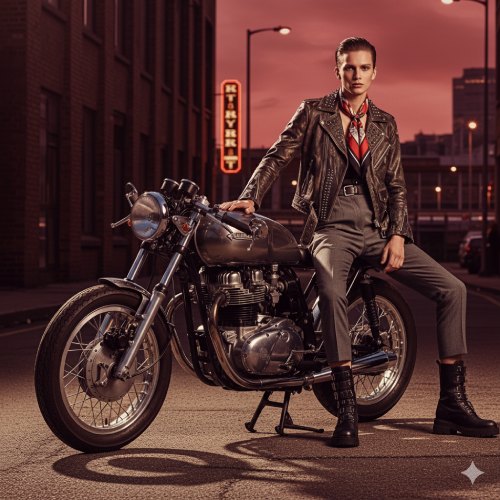 I was leaving behind that millennial Brittany, blessed by its granite, standing like a shoulder of eternity, and when the sky blazed with a burning red, resembling the wrapping of Fahrenheit, which dares to claim it can hold infinity in such a trifling glass bottle, I admired this spectacle of dawn. The roar of the engine and the hoarse power of the 530cc echoed through the narrow streets of Pleslin like thunder rising from the depths of the ages. I was heading back to the capital, and this departure reminded me of mornings from another life, when, thirty years earlier, I tore myself from the warmth of a bed to write to the one I had just left, as if a single hour of absence already carved the abyss of eternity.
I was leaving behind that millennial Brittany, blessed by its granite, standing like a shoulder of eternity, and when the sky blazed with a burning red, resembling the wrapping of Fahrenheit, which dares to claim it can hold infinity in such a trifling glass bottle, I admired this spectacle of dawn. The roar of the engine and the hoarse power of the 530cc echoed through the narrow streets of Pleslin like thunder rising from the depths of the ages. I was heading back to the capital, and this departure reminded me of mornings from another life, when, thirty years earlier, I tore myself from the warmth of a bed to write to the one I had just left, as if a single hour of absence already carved the abyss of eternity.
The speed and the heat of the waning summer carried me to push the machine beyond the allowed limits, as though dawn itself stirred in me the urge to flee these three Breton months. Along the straights and the bends, I thought back to that dawn of my youth upon which I had invented the ghost of a woman to adore; and it was only at the dawn of my forties that I saw that phantom take flesh. Thus life forges in us invisible idols that we carry within until the day they deign to reveal themselves. Continue reading

